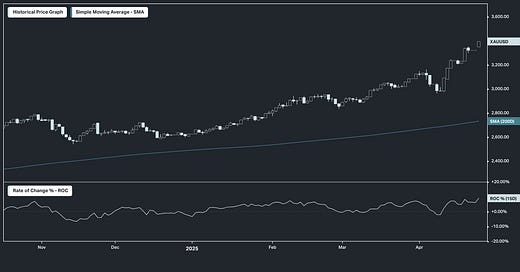Gold Spot US Dollar
US stocks closed mixed ahead of the Good Friday holiday, as investors weighed trade talks and interest rate uncertainty.
The S&P 500 added 0.1%, boosted by gains from Eli Lilly, which surged 14.3% after its weight-loss pill matched Ozempic's performance in a diabetes trial, and Apple, which rebounded 1.4%.
Netflix rose 1.2% ahead of its upcoming earnings report.
Market sentiment was mixed as investors digested President Trump’s comments on “big progress” in trade talks with Japan and his push for a deal with China.
Jitters over tariffs and Trump’s renewed criticism of Fed Powell, including calls for rate cuts, added to the uncertainty.
This is a Note originally shared with GRYNING | Trader clients on March 21, 2025. The original Note can be viewed here. To gain access to more of our research, click on the button below.
As of March 21, 2025, gold prices have reached unprecedented levels, surpassing $3,057 per ounce for the first time. This surge can be interpreted to be driven primarily by two main factors: global de-dollarisation efforts and increased demand for safe-haven assets amid economic uncertainty.
The U.S. decision to leverage the dollar's dominant global position following the invasion of Ukraine—specifically by restricting Russia’s access to the SWIFT financial network—has intensified concerns about reliance on the dollar. In response, China has strategically diversified its reserves, significantly increasing its gold holdings by approximately 15% since November 2022. Given gold’s limited annual production and inflexible mining capacity, such heightened demand has substantially driven up prices.
In addition, investors have increasingly sought gold as protection against rising uncertainty, including fears of persistent inflation, potential economic downturns, and anticipated tariff disruptions. Historically, gold has demonstrated a low correlation with stock markets, often providing positive returns during equity downturns and thus serving as an effective hedge.
However, gold investments carry substantial risks, particularly volatility comparable to the S&P 500, making it less stable than widely perceived. Additionally, gold’s effectiveness as an inflation hedge is uncertain; while it has outpaced inflation over the past two decades, it underperformed during the two decades prior. Historical evidence suggests that after reaching record highs, gold typically yields lower or negative returns.
The current peak has prompted intense activity in gold resale markets, especially in Switzerland—home to major refineries experiencing record gold exports to the U.S. Investors face the critical question of whether to capitalise on current prices or retain their holdings in expectation of further appreciation. Experts recommend a selective, case-by-case approach tailored to individual investment goals, risk tolerance, and liquidity needs, especially given uncertainty about gold’s ability to sustain these historically high valuations.
Our trend signals suggest that it is not yet the time to take profits from gold positions.
The chart below shows the current price of Gold, $3394, up 12% from the delivery of the above note.
Our Daily and Monthly Reports let you easily see all the trends and potential market turning points as picked up by our Trend Signals.
The reports cover about 450 systemic assets and about 850 single stocks.
The systemic assets are bond, equity and commodity indices, as well as a selection of currency pairs.
The single stocks are mainly US and European equities.
To gain access to the full analysis (sample report), sign up using the button below.








